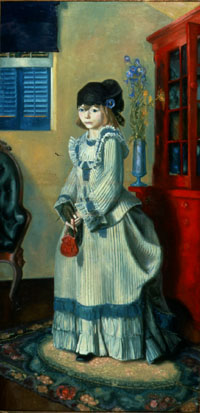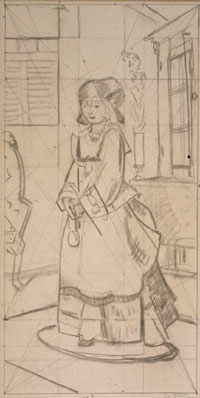
George Bellows' "Lady Jean" (above) has been in the Yale Art Gallery's collection since 1961, but the study drawing (below) for the work was given by Warren and Jan Adelson just this year. Both the study and the finished painting are on view in the new exhibit.
|
masterpieces explores creative process
Like writers, artists use rough drafts to work out their ideas for a painting or sculpture, and, like early incarnations of written works, these preparatory sketches and drawings are often treasured for the insights they give into the creative process.
The next exhibit at the Yale University Art Gallery, "From John Trumbull to Edward Hopper: The Making of American Masterpieces," will feature artists' studies on paper, on canvas and in bronze, along with the completed works that they presaged.
These works, from the gallery's American collections, will be displayed on the museum's first floor Oct. 29-Jan. 2, while the American galleries undergo a complete renovation.
In 1832, the patriot-artist John Trumbull gave more than 100 of his paintings to Yale, creating the first college art museum in the western hemisphere. Since then, the Yale Art Gallery's department of prints, drawings and photographs has acquired studies for many of Trumbull's works, including one of the best-known American images, "The Declaration of Independence, 4, July, 1776." This and three other Trumbull history paintings will be on display in the new exhibit, along with studies on paper and an oil sketch.
Of the many paintings by Thomas Eakins (1844-1916) in Yale's collection, three will be shown with related preparatory works. Since 1932, Yale has owned the oil, "John Biglin in a Single Scull," thought to be a study for a watercolor of the same subject. In 1998, Paul Mellon gave the watercolor to the Yale Art Gallery and both works will be in the new exhibit. Eakins's portrait, "Katherine (Girl with a Cat)" will be shown next to his graphite study of the young woman, and his oil sketch "William Rush Carving his Allegory of the Schuylkill River" will be accompanied by two small bronze figure studies he sculpted.
In 1937 the Yale Art Gallery received an extensive bequest of works by Edwin Austin Abbey (1852-1911) from the artist's widow. These included numerous studies which will be exhibited, along with two finished paintings based on plays by Shakespeare: "Richard, Duke of Gloucester, and the Lady Anne" and "The Play Scene in Hamlet."
The exhibit will also include three studies for "Sunlight in a Cafeteria" by Edward Hopper (1882-1967) along with the final painted composition; and "Lady Jean," a portrait of a young girl, by George Bellows (1882-1925), which will be shown with a preparatory drawing given to Yale just this year.
The installation also features pieces from the decorative arts collection, a silver and lapis lazuli bowl designed by Charlotte Bone, together with her drawing of the design, and Tom Loeser's "Folding Chair" with his preparatory drawing.
The redesign and rehanging of the American collections is the first major change to the Garvan Galleries of American Arts and the American Experience since their opening in 1973.
The Yale University Art Gallery, located at 1111 Chapel St., is open to the public without charge Tuesday-Saturday, 10 a.m.-5 p.m., and Sunday, 1-6 p.m. It is closed Mondays and major holidays. A wheelchair-accessible entrance is at 201 York St., with a reserved parking space nearby. For taped general and program information, call (203) 432-0600 or check the gallery's website at www.yale.edu/artgallery.
T H I S
Bulletin Home
 W E E K ' S
W E E K ' S S T O R I E S
S T O R I E S![]()
 School of Music gets $10 million
School of Music gets $10 million![]()
![]()
 Yale scientists find way to restimulate brain cell growth
Yale scientists find way to restimulate brain cell growth
![]()
![]()
 Center's addition puts families and children at heart of Medical School
Center's addition puts families and children at heart of Medical School![]()
![]()
 Glamour lauds senior for commitment to public education
Glamour lauds senior for commitment to public education![]()
![]()
 Personalities overshadow issues in politics today, says journalist
Personalities overshadow issues in politics today, says journalist![]()
![]()
 Divinity School honoring work of feminist theologian Letty Russell
Divinity School honoring work of feminist theologian Letty Russell![]()
![]()
 Students turn passion for education into teaching careers
Students turn passion for education into teaching careers![]()
![]()
 Retrospective exhibit showcases works of British Pop artist
Retrospective exhibit showcases works of British Pop artist![]()
![]()
 Exhibit of artists' rough drafts for masterpieces explores creative process
Exhibit of artists' rough drafts for masterpieces explores creative process![]()
![]()
 Peabody exhibit pays tribute to pioneering scientist O.C. Marsh
Peabody exhibit pays tribute to pioneering scientist O.C. Marsh![]()
![]()
 Architecture School highlights Daniel Libeskind's latest projects
Architecture School highlights Daniel Libeskind's latest projects![]()
![]()
 Study identifies common fears about genetic testing
Study identifies common fears about genetic testing![]()
![]()
 Grant to the Yale Cancer Center will support lymphoma research
Grant to the Yale Cancer Center will support lymphoma research![]()
![]()
 Yale singers' first production is a sampling of opera scene
Yale singers' first production is a sampling of opera scene![]()
![]()
 Divinity School event welcomes prospective students
Divinity School event welcomes prospective students![]()
![]()
 Pioneering biologist Clement L. Markert dies at age 82
Pioneering biologist Clement L. Markert dies at age 82![]()
![]()
 Community can remember deceased loved ones at Evensong Service
Community can remember deceased loved ones at Evensong Service![]()
![]()
 Workshops promoting collaborative research on women's health issues
Workshops promoting collaborative research on women's health issues![]()
![]()
 Search committee for dean of engineering
Search committee for dean of engineering![]()
![]()
 . . . In the News . . .
. . . In the News . . .![]()
![]()
 Campus Notes
Campus Notes![]()
![]()
 A Day of Dance: A Photo Essay
A Day of Dance: A Photo Essay![]()
 |
| Visiting on Campus
Visiting on Campus |
| Calendar of Events
Calendar of Events |
| Bulletin Board
Bulletin Board![]()
Classified Ads |
| Search Archives
Search Archives |
| Production Schedule
Production Schedule |
| Bulletin Staff
Bulletin Staff![]()
Public Affairs Home |
| News Releases
News Releases |
| E-Mail Us
E-Mail Us |
| Yale Home Page
Yale Home Page
